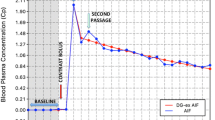Abstract
The objective of this study is to quantify the in vivo kinematics of the superficial femoral artery (SFA) caused by hip and knee flexion by utilizing vascular and skeletal magnetic resonance (MR) imaging and image processing methods. Seven male healthy volunteers (56 ± 5 years old) were imaged using contrast-enhanced MR angiography in the supine and bent-leg positions using a GE Signa Excite 1.5-T scanner. Coregistered SFA coordinates from these two body positions provide the relative motion of the SFA with respect to the femur as a result of hip and knee flexion. With 86 ± 6° hip and 39 ± 6° knee flexion angles, the proximal portion of the SFA moved significantly inferiorly while the distal portion of the SFA stayed immobile in relation to the femur due to hip and knee flexion. From the supine position to the bent-leg position, the top of the SFA moved 23.5 ± 7.0 mm closer to the bottom of the SFA (p < 0.05), resulting in shortening and buckling of the SFA. The differential translations of points along the SFA indicate shortening and buckling along the length of the vessel. They also indicate that the SFA is more tethered to the bony structures at the knee compared to the thigh. The in vivo SFA kinematics obtained in this study provides insight into the interaction between the SFA and the surrounding musculoskeletal structures.





Similar content being viewed by others
References
Scheinert, D., Scheinert, S., Sax, J., Piorkowski, C., Braunlich, S., Ulrich, M., et al. (2005). Prevalence and clinical impact of stent fractures after femoropopliteal stenting. Journal of the American College of Cardiology, 45, 312–315.
Arena, F. J. (2005). Arterial kink and damage in normal segments of the superficial femoral and popliteal arteries abutting nitinol stents-a common cause of late occlusion and restenosis? A single-center experience. Journal of Invasive Cardiology, 17, 482–486.
Duda, S. H., Bosiers, M., Lammer, J., Scheinert, D., Zeller, T., Tielbeek, A., et al. (2005). Sirolimus-eluting versus bare nitinol stent for obstructive superficial femoral artery disease: The SIROCCO II trial. Journal of Vascular and Interventional Radiology, 16, 331–338.
Duda, S. H., Pusich, B., Richter, G., Landwehr, P., Oliva, V. L., Tielbeek, A., et al. (2002). Sirolimus-eluting stents for the treatment of obstructive superficial femoral artery disease: Six-month results. Circulation, 106, 1505–1509.
Solis, J., Allaqaband, S., & Bajwa, T. (2006). A case of popliteal stent fracture with pseudoaneurysm formation. Catheterization and Cardiovascular Interventions, 67, 319–322.
Zeller, T. (2007). Current state of endovascular treatment of femoro-popliteal artery disease. Vascular Medicine, 12, 223–234.
Smedby, O. (1998). Geometrical risk factors for atherosclerosis in the femoral artery: A longitudinal angiographic study. Annals of Biomedical Engineering, 26, 391–397.
Smedby, O., & Bergstrand, L. (1996). Tortuosity and atherosclerosis in the femoral artery: What is cause and what is effect? Annals of Biomedical Engineering, 24, 474–480.
Ní Ghriallais, R., & Bruzzi, M. (2014). A computational analysis of the deformation of the femoropopliteal artery with stenting. ASME. Journal of Biomechanical Engineering, 136, 071003–071003-10.
MacTaggart, J. N., Phillips, N. Y., Lomneth, C. S., Pipinos, I. I., Bowen, R., Baxter, B. T., et al. (2014). Three-dimensional bending, torsion and axial compression of the femoropopliteal artery during limb flexion. Journal of Biomechanics, 47, 2249–2256.
Gökgöl, C., Diehm, N., Kara, L., & Büchler, P. (2013). Quantification of popliteal artery deformation during leg flexion in subjects with peripheral artery disease: a pilot study. Journal of Endovascular Therapy, 20, 828–835.
Smouse, H. B., Nikanorov, A., & Laflashi, D. (2005). Biomechancial forces in the femoropopliteal arterial segment. Endovascular Today, 6, 60–66.
Wensing, P. J., Scholten, F. G., Buijs, P. C., Hartkamp, M. J., Mali, W. P., & Hillen, B. (1995). Arterial tortuosity in the femoropopliteal region during knee flexion: A magnetic resonance angiographic study. Journal of Anatomy, 187, 133–139.
Wood, N. B., Zhao, S. Z., Zambanini, A., Jackson, M., Gedroyc, W., Thom, S. A., et al. (2006). Curvature and tortuosity of the superficial femoral artery: A possible risk factor for peripheral arterial disease. Journal of Applied Physiology, 101, 1412–1418.
Cheng, C. P., Wilson, N. M., Hallett, R. L., Herfkens, R. J., & Taylor, C. A. (2006). In vivo MR angiographic quantification of axial and twisting deformations of the superficial femoral artery resulting from maximum hip and knee flexion. Journal of Vascular and Interventional Radiology, 17, 979–987.
Cheng, C. P., Choi, G., Herfkens, R. J., & Taylor, C. A. (2010). The effect of aging on deformations of the superficial femoral artery due to hip and knee flexion: potential clinical implications. Journal of Vascular and Interventional Radiology, 21, 195–202.
Draney, M. T., Alley, M. T., Tang, B. T., Wilson, N. M., Herfkens, R. J., & Taylor, C. A. (2002). Importance of 3D nonlinear gradient corrections for quantitative analysis of 3D MR angiographic data. In Proceedings of the International Society for Magnetic Resonance in Medicine. Honolulu, HI.
Choi, G., Cheng, C. P., Wilson, N. M., & Taylor, C. A. (2009). Methods for quantifying three-dimensional deformation of arteries due to pulsatile and nonpulsatile forces: Implications for the design of stents and stent grafts. Annals of Biomedical Engineering, 37, 14–33.
Acknowledgments
The authors wish to acknowledge Dr. Charles A. Taylor and the support of the members of the RESIStent Consortium on Stent Failure in the Superficial Femoral Artery, and funding from Cordis, Boston Scientific, W.L. Gore, Cook, Medtronic Vascular, Abbott Vascular, Edwards LifeSciences, and Bard/Angiomed.
Author information
Authors and Affiliations
Corresponding author
Rights and permissions
About this article
Cite this article
Choi, G., Cheng, C.P. Quantification of In Vivo Kinematics of Superficial Femoral Artery due to Hip and Knee Flexion Using Magnetic Resonance Imaging. J. Med. Biol. Eng. 36, 80–86 (2016). https://doi.org/10.1007/s40846-016-0116-1
Received:
Accepted:
Published:
Issue Date:
DOI: https://doi.org/10.1007/s40846-016-0116-1




